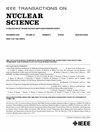Adaptive Modeling Pulsed Neutron Burst Shape for Acquiring Net Inelastic Gamma Spectra
IF 1.9
3区 工程技术
Q3 ENGINEERING, ELECTRICAL & ELECTRONIC
引用次数: 0
Abstract
Compact pulsed neutron generators emit fast neutrons that interact with the medium by inelastic scattering, producing characteristic gamma rays that reflect the concentrations of important elements, such as carbon and oxygen. The detection of these elements is crucial for applications such as detecting explosives, organic carbon, and density. In actual measurement, a proportion of the capture gamma rays is subtracted from the gamma rays collected during the neutron burst to obtain a net inelastic gamma spectrum. However, the different shapes of pulsed neutron burst due to hardware limitations can affect the subtraction factors of capture gamma rays. To address this challenge, an adaptive method for acquiring the net inelastic gamma energy spectra based on pulsed neutron burst shape modeling is proposed. The distribution function of capture gamma ray over time in the pulse period is derived based on modeling of the pulsed neutron burst shape and convolution. The fall and stable point on the pulsed neutron burst shape are adaptively identified through gradients and autocorrelation coefficients. Finally, a more accurate net inelastic gamma spectrum is obtained by calculating the subtraction factors during the burst based on the fit capture gamma time spectra. The different pulsed neutron burst shapes and environmental parameters are considered, and the adaptability and accuracy of our proposed method are verified through the Monte Carlo simulation.获取净非弹性伽马能谱的脉冲中子爆发形状自适应建模
紧凑型脉冲中子发生器发射的快中子通过非弹性散射与介质相互作用,产生特征伽马射线,反映碳和氧等重要元素的浓度。检测这些元素对于检测爆炸物、有机碳和密度等应用至关重要。在实际测量中,俘获伽马射线的一部分会从中子爆发期间收集的伽马射线中减去,从而得到非弹性伽马净光谱。然而,由于硬件的限制,脉冲中子爆发的不同形状会影响俘获伽马射线的减去系数。为解决这一难题,我们提出了一种基于脉冲中子脉冲串形状建模的自适应方法来获取净非弹性伽马能谱。根据脉冲中子猝发形状建模和卷积,得出俘获伽马射线在脉冲周期内随时间变化的分布函数。通过梯度和自相关系数自适应地识别脉冲中子猝发形状上的下降点和稳定点。最后,根据拟合俘获伽马时间频谱,计算脉冲串期间的减去因子,从而获得更精确的非弹性伽马净频谱。我们考虑了不同的脉冲中子猝发形状和环境参数,并通过蒙特卡罗模拟验证了我们提出的方法的适应性和准确性。
本文章由计算机程序翻译,如有差异,请以英文原文为准。
求助全文
约1分钟内获得全文
求助全文
来源期刊

IEEE Transactions on Nuclear Science
工程技术-工程:电子与电气
CiteScore
3.70
自引率
27.80%
发文量
314
审稿时长
6.2 months
期刊介绍:
The IEEE Transactions on Nuclear Science is a publication of the IEEE Nuclear and Plasma Sciences Society. It is viewed as the primary source of technical information in many of the areas it covers. As judged by JCR impact factor, TNS consistently ranks in the top five journals in the category of Nuclear Science & Technology. It has one of the higher immediacy indices, indicating that the information it publishes is viewed as timely, and has a relatively long citation half-life, indicating that the published information also is viewed as valuable for a number of years.
The IEEE Transactions on Nuclear Science is published bimonthly. Its scope includes all aspects of the theory and application of nuclear science and engineering. It focuses on instrumentation for the detection and measurement of ionizing radiation; particle accelerators and their controls; nuclear medicine and its application; effects of radiation on materials, components, and systems; reactor instrumentation and controls; and measurement of radiation in space.
 求助内容:
求助内容: 应助结果提醒方式:
应助结果提醒方式:


